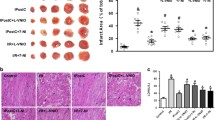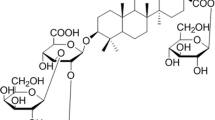Abstract
Remifentanil postconditioning (RPC) elicits cardioprotection against ischemia/reperfusion injury (IRI) by attenuating apoptosis associated with endoplasmic reticulum stress (ERS). Histone H3, acetylation modifications of histone H3, and histone deacetylases (HDAC) also have key roles in the mediation of the survival and apoptosis of cardiomyocytes. In this study, an in vitro IRI model was established with H9c2 cardiomyoblasts to investigate the role of histone H3 acetylation and HDAC3 in RPC-induced attenuation of ERS-associated apoptosis. Briefly, H9c2 cardiomyoblasts were randomly subjected to hypoxia/reoxygenation with and without remifentanil administered at the onset of reoxygenation. Results showed that RPC increased cell viability and prevented cell apoptosis (evidenced by CCK-8 cell viability assays and flow cytometry), and these effects were accompanied by lower levels of expression of GRP78, CHOP, cleaved caspase-12, and cleaved caspase-3. RPC also mimicked the effects of SAHA by increasing the amount of histone H3 deacetylation and decreasing up-regulation of HDAC at both the mRNA and protein levels in response to HR. Finally, RPC-induced protective effects against HR, including attenuation of ERS-associated protein markers, deacetylation of histone H3, and down-regulation of HDAC3 were completely abolished by pretreatment with thapsigargin (TG, a specific ERS activator). In contrast, these effects were not found to be enhanced after pretreatment with 4-phenyl butyric acid (4-PBA, a widely used ERS inhibitor). The present results demonstrate that RPC protects H9c2 cardiomyoblasts from HR injury, and this protection involves an attenuation of ERS-associated apoptosis, which mediates a reduction in HDAC3 expression and an increase in histone H3 deacetylation.





Similar content being viewed by others
References
Xia Z, Li H, Irwin MG (2016) Myocardial ischaemia reperfusion injury: the challenge of translating ischaemic and anaesthetic protection from animal models to humans. Br J Anaesth 117(suppl 2):ii44–ii62. doi:10.1093/bja/aew267
Tanaka K, Kersten JR, Riess ML (2014) Opioid-induced cardioprotection. Curr Pharm Des 20(36):5696–5705
Irwin MG, Wong GT (2015) Remifentanil and opioid-induced cardioprotection. J Cardiothorac Vasc Anesth 29(Suppl 1):S23–S26. doi:10.1053/j.jvca.2015.01.021
Cimen NK, Kosem B, Cimen T, Kartal S, Muslu B, Karabayirli S, Gozdemir M, Kilinc H (2016) Effects of remifentanil, nitroglycerin, and sevoflurane on the corrected QT and Tp-e intervals during controlled hypotensive anesthesia. J Clin Anesth 33:365–372. doi:10.1016/j.jclinane.2016.04.048
Rasmussen LA, Ryhammer PK, Greisen J, Bhavsar RR, Lorentzen AG, Jakobsen CJ (2016) Ultrashort acting remifentanil is not superior to long-acting sufentanil in preserving cognitive function-a randomized study. J Clin Anesth 33:127–134. doi:10.1016/j.jclinane.2016.03.023
Chen L, Chen M, Du J, Wan L, Zhang L, Gu E (2016) Hyperglycemia attenuates remifentanil postconditioning-induced cardioprotection against hypoxia/reoxygenation injury in H9c2 cardiomyoblasts. J Surg Res 203(2):483–490. doi:10.1016/j.jss.2016.03.052
Zuo Y, Cheng X, Gu E, Liu X, Zhang L, Cao Y (2014) Effect of aortic root infusion of sufentanil on ischemia-reperfusion injury in patients undergoing mitral valve replacement. J Cardiothorac Vasc Anesth 28(6):1474–1478. doi:10.1053/j.jvca.2014.04.023
Cominacini L, Mozzini C, Garbin U, Pasini A, Stranieri C, Solani E, Vallerio P, Tinelli IA, Fratta Pasini A (2015) Endoplasmic reticulum stress and Nrf2 signaling in cardiovascular diseases. Free Radic Biol Med 88(Pt B):233–242. doi:10.1016/j.freeradbiomed.2015.05.027
Yu Y, Sun G, Luo Y, Wang M, Chen R, Zhang J, Ai Q, Xing N, Sun X (2016) Cardioprotective effects of Notoginsenoside R1 against ischemia/reperfusion injuries by regulating oxidative stress- and endoplasmic reticulum stress- related signaling pathways. Sci Rep 6:21730. doi:10.1038/srep21730
Liao F, Zheng Y, Cai J, Fan J, Wang J, Yang J, Cui Q, Xu G, Tang C, Geng B (2015) Catestatin attenuates endoplasmic reticulum induced cell apoptosis by activation type 2 muscarinic acetylcholine receptor in cardiac ischemia/reperfusion. Sci Rep 5:16590. doi:10.1038/srep16590
Chen R, Kang R, Fan XG, Tang D (2014) Release and activity of histone in diseases. Cell Death Dis 5:e1370. doi:10.1038/cddis.2014.337
Wu D, Ingram A, Lahti JH, Mazza B, Grenet J, Kapoor A, Liu L, Kidd VJ, Tang D (2002) Apoptotic release of histones from nucleosomes. J Biol Chem 277(14):12001–12008. doi:10.1074/jbc.M109219200
Barrero CA, Perez-Leal O, Aksoy M, Moncada C, Ji R, Lopez Y, Mallilankaraman K, Madesh M, Criner GJ, Kelsen SG, Merali S (2013) Histone 3.3 participates in a self-sustaining cascade of apoptosis that contributes to the progression of chronic obstructive pulmonary disease. Am J Respir Crit Care Med 188(6):673–683. doi:10.1164/rccm.201302-0342OC
Zhang Z, Qin X, Tong N, Zhao X, Gong Y, Shi Y, Wu X (2012) Valproic acid-mediated neuroprotection in retinal ischemia injury via histone deacetylase inhibition and transcriptional activation. Exp Eye Res 94(1):98–108. doi:10.1016/j.exer.2011.11.013
Huang H, Chen HW, Evankovich J, Yan W, Rosborough BR, Nace GW, Ding Q, Loughran P, Beer-Stolz D, Billiar TR, Esmon CT, Tsung A (2013) Histones activate the NLRP3 inflammasome in Kupffer cells during sterile inflammatory liver injury. J Immunol 191(5):2665–2679. doi:10.4049/jimmunol.1202733
Bosmann M, Grailer JJ, Ruemmler R, Russkamp NF, Zetoune FS, Sarma JV, Standiford TJ, Ward PA (2013) Extracellular histones are essential effectors of C5aR- and C5L2-mediated tissue damage and inflammation in acute lung injury. FASEB J 27(12):5010–5021. doi:10.1096/fj.13-236380
Liang DY, Li X, Clark JD (2013) Epigenetic regulation of opioid-induced hyperalgesia, dependence, and tolerance in mice. J Pain 14(1):36–47. doi:10.1016/j.jpain.2012.10.005
Xie M, Kong Y, Tan W, May H, Battiprolu PK, Pedrozo Z, Wang ZV, Morales C, Luo X, Cho G, Jiang N, Jessen ME, Warner JJ, Lavandero S, Gillette TG, Turer AT, Hill JA (2014) Histone deacetylase inhibition blunts ischemia/reperfusion injury by inducing cardiomyocyte autophagy. Circulation 129(10):1139–1151. doi:10.1161/CIRCULATIONAHA.113.002416
Kee HJ, Kook H (2011) Roles and targets of class I and IIa histone deacetylases in cardiac hypertrophy. J Biomed Biotechnol 2011:928326. doi:10.1155/2011/928326
Paillard M, Tubbs E, Thiebaut PA, Gomez L, Fauconnier J, Da Silva CC, Teixeira G, Mewton N, Belaidi E, Durand A, Abrial M, Lacampagne A, Rieusset J, Ovize M (2013) Depressing mitochondria-reticulum interactions protects cardiomyocytes from lethal hypoxia-reoxygenation injury. Circulation 128(14):1555–1565. doi:10.1161/CIRCULATIONAHA.113.001225
Headrick JP, See Hoe LE, Du Toit EF, Peart JN (2015) Opioid receptors and cardioprotection—‘opioidergic conditioning’ of the heart. Br J Pharmacol 172(8):2026–2050. doi:10.1111/bph.13042
Sahbaie P, Liang DY, Shi XY, Sun Y, Clark JD (2016) Epigenetic regulation of spinal cord gene expression contributes to enhanced postoperative pain and analgesic tolerance subsequent to continuous opioid exposure. Mol Pain. doi:10.1177/1744806916641950
Campos EI, Reinberg D (2009) Histones: annotating chromatin. Annu Rev Genet 43:559–599. doi:10.1146/annurev.genet.032608.103928
Marinova Z, Ren M, Wendland JR, Leng Y, Liang MH, Yasuda S, Leeds P, Chuang DM (2009) Valproic acid induces functional heat-shock protein 70 via Class I histone deacetylase inhibition in cortical neurons: a potential role of Sp1 acetylation. J Neurochem 111(4):976–987. doi:10.1111/j.1471-4159.2009.06385.x
Ren M, Leng Y, Jeong M, Leeds PR, Chuang DM (2004) Valproic acid reduces brain damage induced by transient focal cerebral ischemia in rats: potential roles of histone deacetylase inhibition and heat shock protein induction. J Neurochem 89(6):1358–1367. doi:10.1111/j.1471-4159.2004.02406.x
Zhao TC, Cheng G, Zhang LX, Tseng YT, Padbury JF (2007) Inhibition of histone deacetylases triggers pharmacologic preconditioning effects against myocardial ischemic injury. Cardiovasc Res 76(3):473–481. doi:10.1016/j.cardiores.2007.08.010
Marciniak SJ, Yun CY, Oyadomari S, Novoa I, Zhang Y, Jungreis R, Nagata K, Harding HP, Ron D (2004) CHOP induces death by promoting protein synthesis and oxidation in the stressed endoplasmic reticulum. Genes Dev 18(24):3066–3077. doi:10.1101/gad.1250704
Miyazaki Y, Kaikita K, Endo M, Horio E, Miura M, Tsujita K, Hokimoto S, Yamamuro M, Iwawaki T, Gotoh T, Ogawa H, Oike Y (2011) C/EBP homologous protein deficiency attenuates myocardial reperfusion injury by inhibiting myocardial apoptosis and inflammation. Arterioscler Thromb Vasc Biol 31(5):1124–1132. doi:10.1161/ATVBAHA.111.224519
Nakagawa T, Zhu H, Morishima N, Li E, Xu J, Yankner BA, Yuan J (2000) Caspase-12 mediates endoplasmic-reticulum-specific apoptosis and cytotoxicity by amyloid-beta. Nature 403(6765):98–103. doi:10.1038/47513
Lu H, Lu L, Xu ZC, Lu YJ, Zhao B, Zhuang L, Hao BB, Zhang F (2014) Tauroursodeoxycholic acid and 4-phenyl butyric acid alleviate endoplasmic reticulum stress and improve prognosis of donation after cardiac death liver transplantation in rats. Hepatobiliary Pancreat Dis Int 13(6):586–593
Zhang Z, Tong N, Gong Y, Qiu Q, Yin L, Lv X, Wu X (2011) Valproate protects the retina from endoplasmic reticulum stress-induced apoptosis after ischemia-reperfusion injury. Neurosci Lett 504(2):88–92. doi:10.1016/j.neulet.2011.09.003
Koga T, Suico MA, Shimasaki S, Watanabe E, Kai Y, Koyama K, Omachi K, Morino-Koga S, Sato T, Shuto T, Mori K, Hino S, Nakao M, Kai H (2015) Endoplasmic reticulum (ER) stress induces sirtuin 1 (SIRT1) expression via the PI3K-Akt-GSK3beta signaling pathway and promotes hepatocellular injury. J Biol Chem 290(51):30366–30374. doi:10.1074/jbc.M115.664169
Geiger S, Holdenrieder S, Stieber P, Hamann GF, Bruening R, Ma J, Nagel D, Seidel D (2006) Nucleosomes in serum of patients with early cerebral stroke. Cerebrovasc Dis 21(1–2):32–37. doi:10.1159/000089591
Acknowledgements
We thank LetPub (http://www.letpub.com) for its linguistic assistance during the preparation of this manuscript.
Authors contributions
EG and MC designed experiments; MC and QL carried out experiments; LC analyzed experimental results. LZ analyzed sequencing data and developed analysis tools. MC wrote the manuscript and EG approved the final manuscript.
Funding
The funding was provided by the Key Research Project of education department of Anhui Province (No. KJ2013A161) and the Natural Science Foundation of China (No. 81341014).
Author information
Authors and Affiliations
Corresponding author
Electronic supplementary material
Below is the link to the electronic supplementary material.
Rights and permissions
About this article
Cite this article
Chen, M., Liu, Q., Chen, L. et al. Remifentanil postconditioning ameliorates histone H3 acetylation modification in H9c2 cardiomyoblasts after hypoxia/reoxygenation via attenuating endoplasmic reticulum stress. Apoptosis 22, 662–671 (2017). https://doi.org/10.1007/s10495-017-1347-5
Published:
Issue Date:
DOI: https://doi.org/10.1007/s10495-017-1347-5




